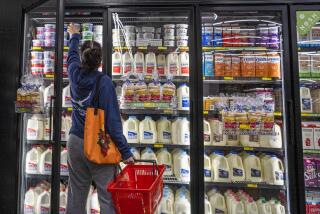Consumers Reduce Borrowing in August
- Share via
Consumers cut back on their borrowing in August by the largest amount since the end of 1990 as confidence in the economy fell and energy prices surged.
The Federal Reserve reported Thursday that consumer credit dropped by a seasonally adjusted annual rate of 1.4% in August, or by $2.4 billion, from the previous month. That was the largest dollar decline since December 1990.
The first decline in nine months left total outstanding consumer credit at $2.04 trillion.
Consumer confidence, as measured by the Conference Board, declined in both August and September, reflecting concerns about the availability of jobs.
Oil prices, meanwhile, set a new high of $52.67 a barrel Thursday.
“I think consumers were spooked by lackluster job creation and frightened by skyrocketing energy prices,” said Richard Yamarone, an economist at Argus Research Corp., discussing consumers’ wariness in August about piling on more debt.
The economy added a net 144,000 jobs in August. The employment report for September will be released by the government today. Economists are predicting that the report will show job gains of around 150,000 and that the unemployment rate held steady at 5.4%.
The Labor Department said Thursday that the number of new people signing up for unemployment insurance benefits fell last week by a seasonally adjusted 37,000 to 335,000, the lowest level since the beginning of September. In the previous three weeks, claims had gone up. Economists were expecting claims to decline to around 355,000.
The Fed’s report includes credit card debt and loans for such things as boats and mobile homes. It does not include real estate loans, such as mortgages or home equity loans.
The pullback in August comes after consumers borrowed briskly in July. They boosted borrowing at a 6.6% pace in July from the previous month, or by $11.2 billion.
In August, consumers let their credit cards cool off. Demand for revolving credit, such as credit cards, fell at a 5.4% annual rate, or by $3.3 billion. That compared with a 9% growth rate in July and a $5.5-billion advance in such credit.
Demand for nonrevolving credit, which includes loans for cars, vacations and education, rose at a 0.9% rate, or $935.9 million, in August. That followed a 5.3% growth rate in July, an increase of nearly $5.7 billion.
More to Read
Inside the business of entertainment
The Wide Shot brings you news, analysis and insights on everything from streaming wars to production — and what it all means for the future.
You may occasionally receive promotional content from the Los Angeles Times.










